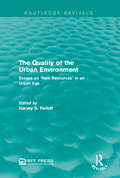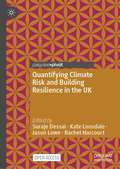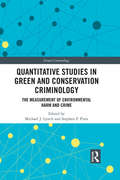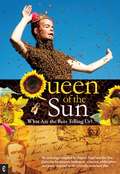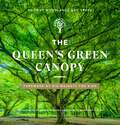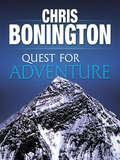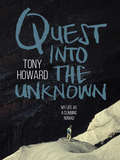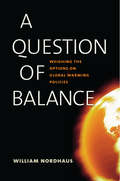- Table View
- List View
The Quality of the Urban Environment: Essays on "New Resources" in an Urban Age (Routledge Revivals)
by Harvey S. PerloffThe quality of the environment in which people live, work, and play influences to no small degree the quality of life itself. The environment can be satisfying and attractive and provide scope for individual development or it can be poisonous, irritating and stunting. The papers in this volume, first published in 1969, are concerned with the urban environment – in which the majority of Americans live – or, more accurately, with the environment of urbanites, for the concern extends to outlying areas where urban dwellers visit and play. The chapters aim to provide a better understanding of the natural resource elements in the urban environment, and will be of interest to students of environmental studies and human geography.
Quantification of Climate Variability, Adaptation and Mitigation for Agricultural Sustainability
by Mukhtar Ahmed Claudio O. StockleThis book is a comprehensive volume dealing with climate change impacts on agriculture, and which can help guide the redesign of agricultural management and cropping systems. It includes mitigation techniques such as use of bioenergy crops, fertilizer and manure management, conservation tillage, crop rotations, cover crops and cropping intensity, irrigation, erosion control, management of drained wetlands, lime amendments, residue management, biochar and biotechnology. It also includesManagement of GHG emissionsCrop models as decision support toolsQTL analysisCrop water productivityImpacts of drought on cereal cropsSilvopastoral systemsChanging climate impact on wheat-based cropping systems of South AsiaPhosphorous dynamics under changing climateRole of bioinformatics The focus of the book is climate change mitigation to enhance sustainability in agriculture. We present various kinds of mitigation options, ways to minimize GHG emissions and better use of the latest techniques in conservation and environmental-sustainability.
Quantified: Redefining Conservation For The Next Economy
by Joe WhitworthIn his book Whitworth draws lessons from the world’s most tech‑savvy, high‑impact organizations to show how we can make real gains for the environment. The principles of his approach, dubbed quantified conservation, will be familiar to any thriving entrepreneur: situational awareness, bold outcomes, innovation and technology, data and analytics, and gain‑focused investment. As President of The Freshwater Trust, Whitworth has put quantified conservation into practice, pioneering the model of a “do‑tank” that is dramatically changing how rivers can get restored across the United States. The stories in Quantified highlight the most precious of resources—water—but they apply to any environmental effort. Whether in the realm of policy, agriculture, business, or philanthropy, Whitworth is charting a new course for conservation.
Quantifying Climate Risk and Building Resilience in the UK
by Suraje Dessai Kate Lonsdale Jason Lowe Rachel HarcourtThis open access book draws together key research from the UK Climate Resilience programme. It focuses on topics central to the programme’s research agenda, including improved characterisation and quantification of climate risks, enhanced understanding of the management of climate risks, and the development and delivery of climate services. Key chapters address the challenges inherent to undertaking resilience research, including how to make the term ‘climate resilience’ usable and useful, co-producing research between academics, policy makers and practitioners, and engaging and communicating outside of academia. This book is unique in providing a concise and accessible overview of the programme’s key lessons, placing the findings into a wider context and it will inform future research, policy and practice agendas.
Quantifying Environmental Impact Assessments Using Fuzzy Logic (Springer Series on Environmental Management)
by Richard B. ShepardFuzzy logic enables people preparing environmental impact statements to quantify complex environmental, economic and social conditions. This reduces the time and cost of assessments, while producing justifiable results.
Quantitative Analyses in Wildlife Science (Wildlife Management and Conservation)
by Leonard A. Brennan Et Al.Over the past fifty years, wildlife science has become increasingly quantitative. But to wildlife scientists, many of whom have not been formally trained as biometricians, computer modelers, or mathematicians, the wide array of available techniques for analyzing wildlife populations and habitats can be overwhelming. This practical book aims to help students and professionals alike understand how to use quantitative methods to inform their work in the field. Covering the most widely used contemporary approaches to the analysis of wildlife populations and habitats, Quantitative Analyses in Wildlife Science is divided into five broad areas:• general statistical methods• demographic estimation• dynamic process modeling• analysis of spatially based data on animals and resources• numerical methodsAddressing a variety of topics, from population estimation and growth trend predictions to the study of migration patterns, this book presents fresh data on such pressing issues as sustainable take, control of invasives, and species reintroduction. Authored by leading researchers in wildlife science, each chapter considers the structure of data in relation to a particular analytical technique, as well as the structure of variation in those data. Providing conceptual and quantitative overviews of modern analytical methods, the techniques covered in this book also apply to conservation research and wildlife policy. Whether a quick refresher or a comprehensive introduction is called for, Quantitative Analyses in Wildlife Science is an indispensable addition to every wildlife professional's bookshelf. Contributors: William M. Block, Leonard A. Brennan, Stephen T. Buckland, Christopher C. Chizinski, Evan C. Cooch, Raymond J. Davis, Stephen J. DeMaso, Randy W. DeYoung, Jane Elith, Joseph J. Fontane, Julie A. Heinrichs, Mevin B. Hooten, Julianna M. A. Jenkins, Zachary S. Laden, Damon B. Lesmeister, Daniel Linden, Jeffrey J. Lusk, Bruce G. Marcot, David L. Miller, Michael L. Morrison, Eric Rexstad, Jamie S. Sanderlin, Joseph P. Sands, Erica F. Stuber, Chris Sutherland, Andrew N. Tri, David B. Wester, Gary C. White, Christopher K. Williams, Damon L. Williford
Quantitative Analyses in Wildlife Science (Wildlife Management and Conservation)
by Leonard A. Brennan Andrew N. Tri Bruce G. MarcotOver the past fifty years, wildlife science has become increasingly quantitative. But to wildlife scientists, many of whom have not been formally trained as biometricians, computer modelers, or mathematicians, the wide array of available techniques for analyzing wildlife populations and habitats can be overwhelming. This practical book aims to help students and professionals alike understand how to use quantitative methods to inform their work in the field. Covering the most widely used contemporary approaches to the analysis of wildlife populations and habitats, Quantitative Analyses in Wildlife Science is divided into five broad areas:• general statistical methods• demographic estimation• dynamic process modeling• analysis of spatially based data on animals and resources• numerical methodsAddressing a variety of topics, from population estimation and growth trend predictions to the study of migration patterns, this book presents fresh data on such pressing issues as sustainable take, control of invasives, and species reintroduction. Authored by leading researchers in wildlife science, each chapter considers the structure of data in relation to a particular analytical technique, as well as the structure of variation in those data. Providing conceptual and quantitative overviews of modern analytical methods, the techniques covered in this book also apply to conservation research and wildlife policy. Whether a quick refresher or a comprehensive introduction is called for, Quantitative Analyses in Wildlife Science is an indispensable addition to every wildlife professional's bookshelf. Contributors: William M. Block, Leonard A. Brennan, Stephen T. Buckland, Christopher C. Chizinski, Evan C. Cooch, Raymond J. Davis, Stephen J. DeMaso, Randy W. DeYoung, Jane Elith, Joseph J. Fontane, Julie A. Heinrichs, Mevin B. Hooten, Julianna M. A. Jenkins, Zachary S. Laden, Damon B. Lesmeister, Daniel Linden, Jeffrey J. Lusk, Bruce G. Marcot, David L. Miller, Michael L. Morrison, Eric Rexstad, Jamie S. Sanderlin, Joseph P. Sands, Erica F. Stuber, Chris Sutherland, Andrew N. Tri, David B. Wester, Gary C. White, Christopher K. Williams, Damon L. Williford
Quantitative and Qualitative Microscopy
by P. Michael ConnMethods in Neurosciences, Volume 3: Quantitative and Qualitative Microscopy is a collection of papers that deals with microscopic techniques in statistical measures. This volume describes microscopy using sophisticated stains and dyes to advance observation of tests and experiments. Section I describes autoradiography including micro chemical methods, high-resolution autoradiography, and single- or double-label quantitative autoradiography for use in imaging of brain activity patterns or determining cerebral physiology. Section II discusses the quantification of structures through statistical and computational methods including dynamic video imaging technology. Section III explains the use of tracers, toxins, or dyes in tracing neuronal connections. One paper addresses the use of small injections of axonally transported fluorescent tracers. Section IV explains staining technology such as using the silver impregnation method for frozen sections of human nervous tissue that are gathered from tissues preserved in formalin. Section V addresses freezing techniques and those using freeze-fracture methods in neurobiology. The text also discusses cryoprotection and other freezing methods to control ice crystals found in fixed or unfixed brain tissues. Section VI presents the combined and high-resolution methods in polarization microscopy and microscopic investigations. Cellular biologists, micro-chemists, and scientific researchers in the field of micro- and cellular biology will appreciate this book.
Quantitative Methods in Environmental and Climate Research
by Michela Cameletti Francesco FinazziThis books presents some of the most recent and advanced statistical methods used to analyse environmental and climate data, and addresses the spatial and spatio-temporal dimensions of the phenomena studied, the multivariate complexity of the data, and the necessity of considering uncertainty sources and propagation. The topics covered include: detecting disease clusters, analysing harvest data, change point detection in ground-level ozone concentration, modelling atmospheric aerosol profiles, predicting wind speed, precipitation prediction and analysing spatial cylindrical data. The volume presents revised versions of selected contributions submitted at the joint TIES-GRASPA 2017 Conference on Climate and Environment, which was held at the University of Bergamo, Italy. As it is chiefly intended for researchers working at the forefront of statistical research in environmental applications, readers should be familiar with the basic methods for analysing spatial and spatio-temporal data.
Quantitative Mineral Resource Assessments: An Integrated Approach
by Donald Singer W. David MenziePolicy makers, mineral exploration experts, and regional planners decide how public lands, which may contain undiscovered resources, should be used or whether to invest in exploration for minerals on a regular basis. Decisions are also made concerning mineral resource adequacy, national policy, and regional development. This book makes explicit the factors that can affect a mineral-related decision so that decision-makers can clearly see the possible consequences of their decisions. Based on work done at the US Geological Survey, the authors address the question of the kinds of issues decision-makers are trying to resolve and what forms of information would aid in resolving these issues. The goal of the process discussed is to offer unbiased quantitative assessments in a format needed in decision-support systems so that consequences of alternative courses of action can be examined with respect to land use or mineral-resource development. An integrated approach focuses on three assessment parts and the models that support them. Although the concepts presented are straightforward and understandable, in assessments, carefully listening to the experts in other disciplines leads to better products. Navigating through and making sense of QRA requires not just learning rules and equations, but life experiences and common sense. The judgment required to understand which tools to apply are best learned by example and experience. This will be useful to governmental or industrial policy makers, managers of explorations, planners of regional development, and similar decision-makers.
Quantitative Risk Assessment for Environmental and Occupational Health
by William H. HallenbeckQuantitative Risk Assessment for Environmental and Occupational Health, Second Edition features twice as many risk analysis models with complete examples as the previous edition. The book features new information in the following areas:Calculation of human dose rate and dose from experimental studies (animal and human)Quantitat
Quantitative Studies in Green and Conservation Criminology: The Measurement of Environmental Harm and Crime (Green Criminology)
by Michael J. Lynch Stephen F. PiresDuring the early development and throughout the short history of green/conservation criminology, limited attention has been directed toward quantitative analyses of relevant environmental crime, law and justice concerns. While recognizing the importance of establishing a theory and terminology in the early stages of development, this book redresses this imbalance. The work features contributions that undertake empirical quantitative studies of green/conservation crime and justice issues by both conservation and green criminologists. The collection highlights the shared concerns of these groups within important forms of ecological crime and victimization, and illustrates the ways in which these approaches can be undertaken quantitatively. It includes quantitative conservation/green criminological studies that represent the work of both well-established scholars in these fields, along with studies by scholars whose works are less well-known and who are also contributing to shaping this area of research. The book presents a valuable contribution to the areas of Green and Conservation Criminology. It will appeal to academics and students working in these areas.
Quantitative Studies in Green and Conservation Criminology: The Measurement of Environmental Harm and Crime (Green Criminology)
by Michael J. Lynch Stephen F. PiresDuring the early development and throughout the short history of green/conservation criminology, limited attention has been directed toward quantitative analyses of relevant environmental crime, law and justice concerns. While recognizing the importance of establishing a theory and terminology in the early stages of development, this book redresses this imbalance. The work features contributions that undertake empirical quantitative studies of green/conservation crime and justice issues by both conservation and green criminologists. The collection highlights the shared concerns of these groups within important forms of ecological crime and victimization, and illustrates the ways in which these approaches can be undertaken quantitatively. It includes quantitative conservation/green criminological studies that represent the work of both well-established scholars in these fields, along with studies by scholars whose works are less well-known and who are also contributing to shaping this area of research. The book presents a valuable contribution to the areas of Green and Conservation Criminology. It will appeal to academics and students working in these areas.
Quantitative Techniques in Participatory Forest Management
by Eugenio Martínez-Falero Susan Martin-Fernandez Antonio D. Garcia-AbrilForest management has evolved from a mercantilist view to a multi-functional one that integrates economic, social, and ecological aspects. However, the issue of sustainability is not yet resolved. Quantitative Techniques in Participatory Forest Management brings together global research in three areas of application: inventory of the forest variabl
Quaternary Deserts and Climatic Change
by A. S. Alsharhan K. W. Glennie G. L. WhittleThese proceedings record the results of climate change in many areas which are hyper-arid deserts today but which, almost cyclically, at intervals of thousands or even hundreds of thousands of years, have had a much more humid climate.
Quaternary Deserts and Climatic Change
by A. S. Alsharhan K. W. Glennie G. L. Whittle C.G. St.C. KENDALLThese proceedings record the results of climate change in many areas which are hyper-arid deserts today but which, almost cyclically, at intervals of thousands or even hundreds of thousands of years, have had a much more humid climate.
The Quaternary in the Tropics: A Reconstruction of the Palaeoclimate (Springer Textbooks in Earth Sciences, Geography and Environment)
by Klaus HeineThe Ice Age (Quaternary) is a period of extreme climate fluctuations that led to the growth and melting of massive ice sheets in the high latitudes. Tropical deserts, savannas, rainforests, and mountainous regions experienced equal dramatic climatic changes of which the traces are preserved in sedimentary deposits. The knowledge of tropical climate history is of paramount importance because in the tropics and marginal tropics, natural and - more recently - human-induced processes significantly control global climate. Yet relatively few palaeoclimate records are known from these regions.This book presents the climate archives of the tropics and critically discusses their palaeoclimatic informative value. Based on decades of research the author demonstrates that a lack of geoecological knowledge leads to misinterpretations in modeling climate futures. The results presented here call for a correction of many widely held views about the role of atmospheric greenhouse gases in global warming over the past 150 years.The book is intended for natural scientists of all disciplines who are looking for a synopsis of the problem area "Our climate in the past, present and future in the tropics".
Queen of the Sun: What are the Bees Telling Us?
by Taggart SiegelIn Autumn 2006 an unnerving phenomenon hit the United States: honeybees were mysteriously disappearing from hives across the nation, with beekeepers reporting losses of between 30 and 90 per cent of their entire colonies. The problem soon spread to parts of Europe and even Asia, earning the name Colony Collapse Disorder. To this day nobody is absolutely sure why it is happening and what the exact causes are. However, in 1923 Rudolf Steiner, a scientist, philosopher and social innovator, predicted that bees would die out within 100 years if they were to be reproduced using only artificial methods. Startlingly, and worryingly, his prediction appears to be coming true.Queen of The Sun, What Are the Bees Telling Us? is a companion book to the critically-acclaimed film of the same name. Compiled by the film’s director Taggart Siegel, it makes a profound examination of the global bee crisis through the eyes of biodynamic and organic beekeepers, scientists, farmers, philosophers and poets. Revealing the mysterious world of the beehive and the complex social community of bees, the book unveils millennia of beekeeping, highlighting our historic and sacred relationship with bees, and how this is being compromised by highly-mechanized and intensive agro-industrial practices. The bees are messengers and their disappearance is a resounding wake-up call for humanity!With full colour, stunning photography throughout, this engaging, alarming but ultimately uplifting anthology begins with an account of how Siegel’s film came to be made. It continues with a wealth of articles, interviews and poems that offer unique philosophical and spiritual insights. Besides investigating many contributory causes of Colony Collapse Disorder, the book offers remedies as well as hope for the future.Queen of the Sun features contributions from Taggart Siegel, Jon Betz, David Heath, Gunther Hauk, Horst Kornberger, Jennifer Kornberger, Jacqueline Freeman, Johannas Wirz, Kerry Grefig, Michael Thiele, Raj Patel, Vandana Shiva, Jeffery Smith and Matthew Barton. These compelling voices signal a growing movement striving to found a culture fully in balance with nature.
The Queen's Green Canopy: Ancient Woodlands and Trees
by Adrian Houston Charles Sainsbury-PlaiceStunning photographs of the United Kingdom's most spectacular trees - with a foreword by His Majesty the King.The Queen's Green Canopy is a beautiful photography book showcasing 70 ancient trees and 70 ancient woodlands dedicated by the QGC initiative in honour of Her Majesty's Platinum Jubilee.The book features extraordinary photographs of the United Kingdom's best-loved trees, many of which inspired historic figures, artists and writers through the centuries.Alongside these photographs are short written pieces from contributors including Dame Judi Dench, Alan Titchmarsh, Dame Joanna Lumley, Adam Henson, Archbishop Justin Welby and Danny Clarke, as well as conservation experts from the Woodland Trust and the Duchy of Cornwall. In these pieces they reflect on the trees that have made a mark on their lives and the importance of protecting Britain's woodlands for future generations.Selected trees include yews at a Cotswold's church which inspired JRR Tolkien; the apple tree believed to have inspired Sir Isaac Newton's theory of gravity; the Five Hundred Acre Wood in East Sussex immortalised in AA Milne's Winnie the Pooh books; and the 2,500-year-old tree where Henry VIII may have proposed to Anne Boleyn.So far 3 million trees have been planted by communities, schools and businesses across the country as part of the QGC initiative. Through incredible imagery and joyful pieces of writing, The Queen's Green Canopy celebrates Her Majesty's extraordinary life and the amazing legacy she leaves behind.
Quercus ilex L. ecosystems: function, dynamics and management (Advances in Vegetation Science #13)
by F. Romane J. TerradasQuest for Adventure: Remarkable feats of exploration and adventure
by Sir Chris BoningtonQuest for Adventure is a collection of stories written by Sir Chris Bonington looking at the adventurous impulse which has driven men and women to achieve the impossible in the face of Earth’s elements: crossing its oceans, deserts and poles; canoeing its rivers; climbing its mountains, and descending into its caves.Bonington selects seventeen of the most thrilling expeditions and adventures of the mid-late twentieth century, uncovering the common thread that drives men and women to achieve the impossible. Following a new preface, he charts such outstanding achievements as Thor Heyerdahl’s Kon-Tiki voyage across the Pacific Ocean; Francis Chichester’s round-the-world tour in his boat Gipsy Moth IV; the race for the first non-stop circumnavigation of the globe under sail; and Ice Bird’s sail around Antarctica.Away from the ocean, the travels of one of the world’s most outstanding desert explorers, Wilfred Thesiger, are detailed, journeying through what is menacingly called the Empty Quarter. Bonington returns to familiar ground as he writes about some exceptional mountain adventures, including the 1970 ascent of the South Face of Annapurna; Hillary and Tenzing’s first ascent of Everest; Reinhold and Gunther Messner on Nanga Parbat; Andy Cave’s triumph and tragedy on Changabang; and the Warren-Harding-led first ascent of The Nose of El Capitan in Yosemite. Wally Herbert’s team crossing of the Arctic Ocean and the equally gruelling Fuchs/Hillary crossing of Antarctica are written about in detail.More recent adventures include the race to make the first circumnavigation of the globe by balloon – a high-stakes race with a high-profile cast, including Richard Branson and Steve Fossett. Quest for Adventure concludes with an account of the cave diving epic the Dead Man’s Handshake, leaving the reader with a chill in their spine and an appreciation for the natural wonders below the Earth’s surface.Bonington’s eloquent writing on a subject in which he is a passionate authority makes for a highly engrossing read for adventurers and armchair explorers alike.
The Quest for the Sustainable Development Goals: Living experiences in territorializing the 2030 Agenda in Brazil (Sustainable Development Goals Series)
by Thiago Gehre Galvao Henrique Zeferino de MenezesThe book presents the experiences, complexities, and contradictions of the implementation of the Sustainable Development Goals in Brazil so far. Through chapters from a variety of stakeholders, the book examines national, regional, and local aspects of development in Brazil. The chapters here draw from scientific knowledge and practical experience to take a critical look at what the SDGs mean in a Global South country and what the implications of this are for global development. The book is divided into three sections. The first section addresses the critical political and institutional aspects related to the implementation of the Sustainable Development Goals in Brazil, highlighting advances as well as pitfalls and setbacks. The chapters look at broad questions related to the role of civil society in defining political priorities and strategies to move forward with the SDGs as well as issues involved in incorporating the SDGs at different levels of government and other institutions. The chapters in this section critically address the political and institutional advances as well as barriers to the progress of the SDGs in Brazil. The second section directly addresses progress made toward the SDGs in the context of the political, economic and social variables specific to Brazil. The chapters address critical shortcomings and demands for Brazilian society: the need for improvements in education and employment policies to reduce poverty, the urgent need to increase gender equality and reduce violence, as well as the imperative to strengthen institutions and policies to mitigate climate change and protect the environment. The final section focuses on critically assessing the 2030 Agenda itself and drawing from a Global South IR perspective. The chapters here dialog with decolonial and post-developmentalist perspectives to highlight problems with the agenda and lift up sidelined priorities, presenting yet-unexamined policy solutions and innovations that are currently absent from the global institutional agenda. The Brazilian case is a perfect illustration of how underdevelopment and political instability can constrain the paths to sustainable development, while at the same time social innovations, leverages based on regional dynamics, and strength from social and cultural diversity can drive sustained progress.
Quest into the Unknown: My life as a climbing nomad
by Tony HowardWe are all climbing where we are and with the gear we use in no small part due to Tony Howard’s quest for adventure.Tony Howard rose to fame in 1965 as a member of a group of young climbers from northern England who made the first British ascent of Norway’s Troll Wall; a climb described by Joe Brown as, ‘One of the greatest ever achievements by British rock climbers’. Tony went on to design the modern sit harness, now used worldwide by most climbers. He founded the company Troll Climbing Equipment but never stopped exploring. Quest into the Unknown is his story.Tony has dedicated his life to travelling the world in search of unclimbed rock faces and remote trekking adventures. The scale of his travels is vast: he has visited all of the North African countries, much of the Arab land of the Middle East, the mountainous regions of Scandinavia, Canada and the rocky spine of the Americas, the Himalaya, remote Indian provinces, South East Asia, Madagascar, South Georgia and Antarctica. This book, the last word in adventure travel, takes the reader from Tony’s youth spent developing the crags of the English Peak District, via whaling ships in the Southern Ocean, thousand-mile canoe trips in the Canadian Arctic, living amongst the Bedouin in the rocky mountains of Jordan, to the isolated opium tribes of Thailand.Tony Howard’s Quest into the Unknown is the jaw-dropping account of a life of adventure that is the very definition of true exploration.
A Question of Balance: Weighing the Options on Global Warming Policies
by Prof. William D. NordhausAs scientific and observational evidence on global warming piles up every day, questions of economic policy in this central environmental topic have taken center stage. But as author and prominent Yale economist William Nordhaus observes, the issues involved in understanding global warming and slowing its harmful effects are complex and cross disciplinary boundaries. For example, ecologists see global warming as a threat to ecosystems, utilities as a debit to their balance sheets, and farmers as a hazard to their livelihoods. In this important work, William Nordhaus integrates the entire spectrum of economic and scientific research to weigh the costs of reducing emissions against the benefits of reducing the long-run damages from global warming. The book offers one of the most extensive analyses of the economic and environmental dynamics of greenhouse-gas emissions and climate change and provides the tools to evaluate alternative approaches to slowing global warming. The author emphasizes the need to establish effective mechanisms, such as carbon taxes, to harness markets and harmonize the efforts of different countries. This book not only will shape discussion of one the world’s most pressing problems but will provide the rationales and methods for achieving widespread agreement on our next best move in alleviating global warming.
The Quick Guide to Wild Edible Plants: Easy to Pick, Easy to Prepare
by Lytton John Musselman Harold J. WigginsA recent rise in the popularity of urban farming, farmers’ markets, and foraging from nature means more people are looking for information about plants. In The Quick Guide to Wild Edible Plants, botanists Lytton John Musselman and Harold J. Wiggins coach you on how to safely identify, gather, and prepare delicious dishes from readily available plants—and clearly indicate which ones to avoid.More than 200 color illustrations, accompanied by detailed descriptions, will help you recognize edible plants such as nettles, daylilies, river oats, and tearthumbs. For decades, Musselman and Wiggins have taught courses on how to prepare local plants, and their field-to-table recipes require only a few, easily found ingredients. They offer instructions for making garlic powder out of field garlic and turning acorns into flour for Rappahannock Acorn Cakes. To toast your new skill, they even include recipes for cordials. The Quick Guide to Wild Edible Plants is a great gift for the beginning naturalist and the perfect addition to every serious forager’s library.
